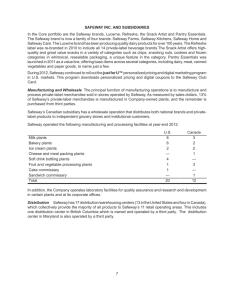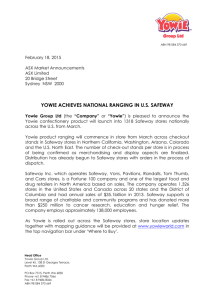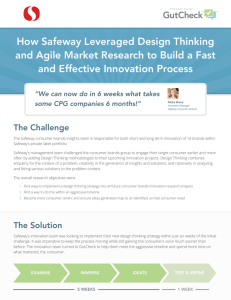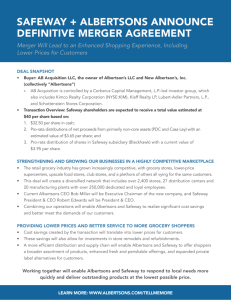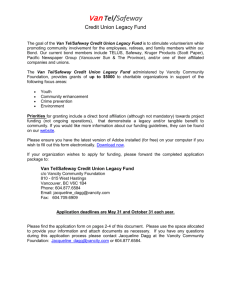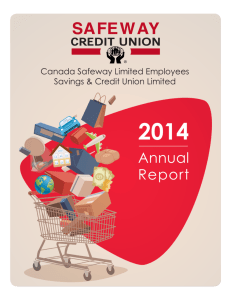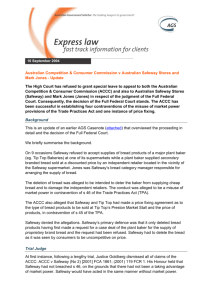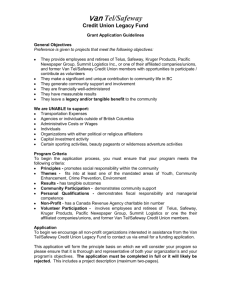safeway project - Victoria Truong
advertisement
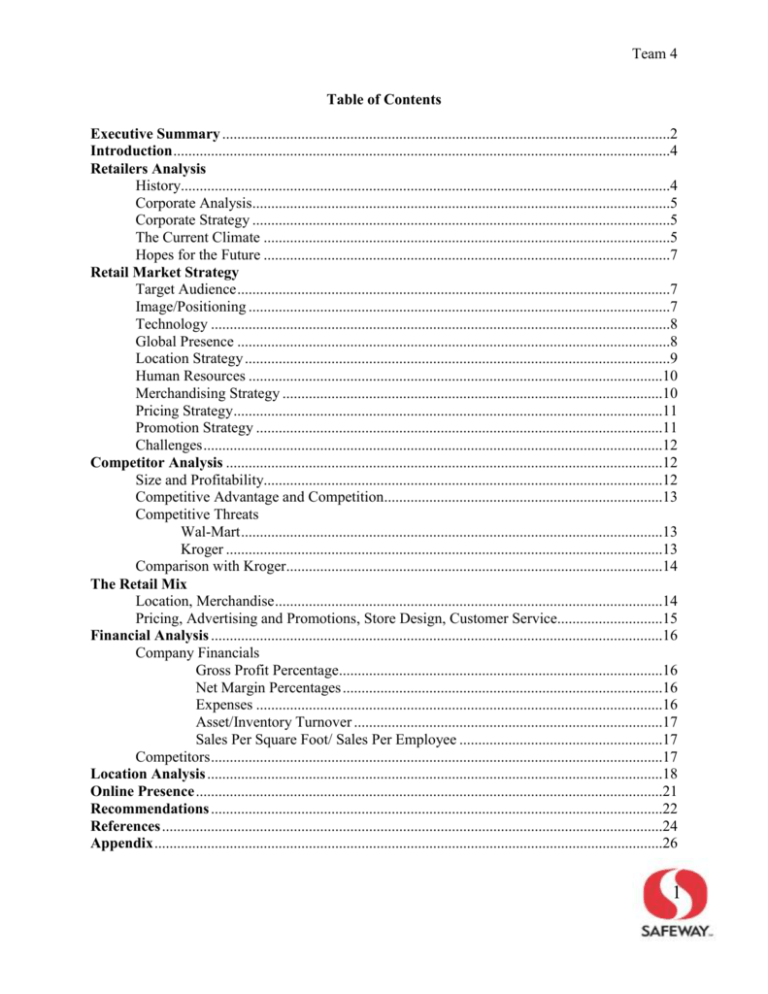
Team 4 Table of Contents Executive Summary .......................................................................................................................2 Introduction ....................................................................................................................................4 Retailers Analysis History..................................................................................................................................4 Corporate Analysis...............................................................................................................5 Corporate Strategy ...............................................................................................................5 The Current Climate ............................................................................................................5 Hopes for the Future ............................................................................................................7 Retail Market Strategy Target Audience ...................................................................................................................7 Image/Positioning ................................................................................................................7 Technology ..........................................................................................................................8 Global Presence ...................................................................................................................8 Location Strategy .................................................................................................................9 Human Resources ..............................................................................................................10 Merchandising Strategy .....................................................................................................10 Pricing Strategy..................................................................................................................11 Promotion Strategy ............................................................................................................11 Challenges ..........................................................................................................................12 Competitor Analysis ....................................................................................................................12 Size and Profitability..........................................................................................................12 Competitive Advantage and Competition..........................................................................13 Competitive Threats Wal-Mart ................................................................................................................13 Kroger ....................................................................................................................13 Comparison with Kroger....................................................................................................14 The Retail Mix Location, Merchandise .......................................................................................................14 Pricing, Advertising and Promotions, Store Design, Customer Service............................15 Financial Analysis ........................................................................................................................16 Company Financials Gross Profit Percentage......................................................................................16 Net Margin Percentages .....................................................................................16 Expenses ............................................................................................................16 Asset/Inventory Turnover ..................................................................................17 Sales Per Square Foot/ Sales Per Employee ......................................................17 Competitors ........................................................................................................................17 Location Analysis .........................................................................................................................18 Online Presence ............................................................................................................................21 Recommendations ........................................................................................................................22 References .....................................................................................................................................24 Appendix .......................................................................................................................................26 1 Team 4 Executive Summary Safeway, Inc. was founded in 1914, and is a top retailer in the supermarket industry. Safeway’s main product mix includes grocery, produce, and general household items. Safeway is currently a parent company to many corporations nationwide, giving it the capability to create many different private labels from high quality brands such as O Organics to the more affordable brands like Pantry Essentials. Currently, Safeway is one of the top five grocery retailers, but is having a difficult time maintaining its market share. The current economic situation and the introduction of new competitors, like supercenters, are factors influencing how Safeway is conducting business. The current economic status is reducing the number of people that can afford to shop at average grocery stores, causing a large portion of the population to switch to grocery shopping at valuebased stores. Supercenters, such as Wal-Mart, are also expanding their grocery lines at prices that are very competitive, making it hard for Safeway to compete and still maintain a profit. With such a broad target audience, Safeway must cater to all differing demographics. After conducting efficient market research, Safeway has implemented both the Just for U program and its membership loyalty program. Together, they provide invaluable data that helps understand its customers’ behavior and the ability to provide specific offers related to its customers’ shopping habits. Through the introduction of the Just for U program, Safeway has created a competitive advantage. No other grocery retailer currently offers a loyalty and rewards program similar to this. Thus, this program offers great opportunity for Safeway to continue and improve its relationship with its customers. Safeway also utilizes its own real estate department called Property Development Centers in order to gain a competitive advantage when it comes to the placement of their stores through higher barriers of entry. 2 Team 4 Safeway is having great successes in tracking its merchandise weekly, which ensures that it is constantly staying up-to-date on which products are selling, and which products are sitting on its shelves. Safeway has recently implemented an “Everyday Low Price” pricing strategy to keep up with its competitors, as well as using direct marketing and in-store signage. Amongst its competitors, Safeway has the least amount of stores, but ranks significantly behind Wal-Mart and Kroger. Safeway’s largest problems are its overhead expenses and general and administrative expenses. The company needs to find ways to cut these, whether it be decreasing store sizes, condensing their supply chain, or finding new ways to decrease in-store costs. By doing this, the company’s net profit will increase, putting the company in a much better financial situation. With Safeway’s online presence at Safeway.com, individuals can order their groceries online and have them delivered to their homes. Coupons are also available online, and customers can get personalized coupons by simply logging on to their Just for U accounts. However, Safeway still needs to update pictures for some of its products and should allow potential customers to browse merchandise without having to create an account. To improve Safeway’s success in the supermarket industry, the company must strengthen its present weaknesses discovered after conducting a SWOT analysis. These weaknesses include: inconsistent culture between stores, the current economic state of the United States, and the fact that there are not any key attributes that differentiate their company from other average supermarkets. To overcome these weaknesses, Safeway should take advantage of the opportunities they have at hand. These opportunities include: the rising popularity of natural foods, expansion in the United States and abroad, and the chance to revamp their private label brands. 3 Team 4 Introduction Safeway, Inc. is a supermarket chain that was founded in 1914 by Sam Seelig with its first location in Los Angeles, California. Safeway has expanded over the United States and into Canada under the names Safeway, Genuardi’s, Randalls and Tom Thumb, Carrs, and Vons. Based in Pleasanton, California, Safeway, Inc. currently operates 1,678 retail locations and employs over 178,000 people. Safeway not only operates it’s own supermarkets, but holds 49% interest in Casa Ley, S.A. de C.V., a food and general merchandise retailer in Mexico, and Blackhawk Networks, Inc., a prepaid card company. Because of the current economic decline, Safeway is having a few troubles with its weaknesses. But if the company takes control of these weaknesses quickly, the future for Safeway will be bright. Retailer Analysis History Safeway Inc. was founded in 1914 by Sam Seelig, and quickly expanded into 240 stores, covering a large portion of the West Coast. In 1926, these 240 stores were purchased by Charles Merrill of Merrill Lynch, and by 1928, the company had expanded to 2,020 stores (Pederson, 2007). The company continued to buy out other grocery store chains, including Arizona Grocery, Piggly Wiggly Pacific, and Vons, and even expanded internationally into Western Canada, the UK, and Australia. In 2002, Safeway launched Safeway.com, which is a grocery shopping and delivery service website. In 2005, it introduced its “O Organics” line, which contains over 150 organic products (Hoovers.com, 2012). Today, most stores include deli, floral, seafood, pharmacy, bakery departments, and many include Starbucks coffee and fueling stations on-site. Safeway, Inc. is viewed as one of the largest food and drug retailers in North America at this time (Datamonitor, 2012). 4 Team 4 Corporate Analysis There is an extensive list of different retailers that Safeway, Inc. is a parent company to. These retailers include: Genuardi’s Family Markets LP, Pak ‘N Save Inc., Randall’s Food & Drugs LP, Carr-Gottstein Foods Co., Safeway Australia Holdings, Inc., Safeway Canada Holdings, Inc., Safeway Corporate, Inc., Safeway Dallas, Inc., Safeway Denver, Inc., Safeway Richmond, Inc., Safeway Southern California, Inc., The Vons Companies, Inc., Dominick’s Finer Foods, LLC, GroceryWorks Holdings, Inc., and Blackhawk Networks, Inc. Safeway also owns many private label brands such as: O Organics, Lucerne, Eating Right, Bright Green Line, Total Pet Care Line, and Value Red Line (Pederson, 2007). Corporate Strategy Safeway’s goal is to provide value to its customers by maintaining superior store standards and a wide selection of quality products at competitive prices (Pederson, 2007). To ensure their ability to do this, Safeway focuses on sustainability within its supply chain and has a strong drive to create virtually zero waste (Vosburgh, 2012). Its private label brands have been very successful, and now Safeway is establishing new private label standards to create better quality and innovation so that the products it offers differ from the products offered by national brands (Gallagher, 2011). In order to ensure an increase in revenue for the future, Safeway CEO Steve Burd plans on using the new and revamped private label brands, as well as price reductions and target marketing to increase future sales for the company (Frederick, 2012). The Current Climate The supermarket industry is an extremely competitive area of retail. Competition has been growing substantially, and Safeway is having a difficult time trying to maintain a considerable portion of the market share. The company’s net income fell 16 percent in the 5 Team 4 second quarter of this year (Choi, 2012). The reduction of success by average supermarket retailers is due largely in part to the fact that more retailers have begun selling groceries. Supercenters, such as Wal-Mart and Target, are now selling groceries, including fresh produce. These have created a “one-stop-shop” atmosphere for consumers who shop at supercenters. Value-based stores and health food markets are also taking some of the market share that once belonged to standard supermarkets. Value-based stores, like The Dollar Tree and The Dollar General, now carry grocery store items as well. Health food markets like Whole Foods, are offering products that are viewed as fresher and healthier than the products carried at average supermarkets, but come at a higher price. Competition is not the only factor hurting Safeway; the current economic conditions are also damaging to the retailer’s success. A higher percentage of the population has started shopping at value-based stores because people can no longer afford to spend more on food. Along with this, high fuel prices and the inflating prices of food are causing Safeway’s prices to rise and profits to fall (Gasparro, 2012). Hopes for the Future In an attempt to retain customer loyalty, Safeway has started to personalize the shopping experience through its loyalty programs. Safeway just implemented its Just for U program, which targets consumers directly with products they are familiar with by offering special coupons or discounts. It is expected that 35% of their business will come from this new program within the next year and will continue to increase to 65 to 70% over the next three years (DeArment, 2012). 6 Team 4 Retail Market Strategy Target Audience Safeway’s target audience is everyone. It virtually caters to all demographics that live in the surrounding areas whatever that demographic may be, but tend to lean toward more affluent customers and geographic areas. Its products can range from the practical inexpensive items to the more expensive luxury items. The psychographic it tries to reach includes people that are not extremely price conscious and are looking for quality over value. In comparison to their direct competition, Safeway seems to be the dominant force in attracting all demographics and psychographics to its stores. However, when competing against stores like Trader Joe’s and Whole Foods that have somewhat different target audiences, Safeway is not as strong. Trader Joe’s offers a majority of its own brands, where its target audience is looking to stretch their dollar a little more for quality products. Whole Foods is more expensive, but offers products of higher quality for people who live a health conscious lifestyle. Image/Positioning The image that Safeway tries to convey is the local and friendly neighborhood grocery store. It is also changing its image by going environmentally friendly, shutting off lights during peak hours, and offering reusable grocery bags. Safeway wants to convey that it truly cares for the environment and the people in it. Safeway positions itself as the one-stop-shop for all of the consumers’ grocery needs. If the consumers have a Just for U club card, the shopping experience is personalized for their specific wants and needs which also gives Safeway the opportunity to monitor how its consumers behave at each location. Customers are also asked if they would like to donate to the charity Safeway is sponsoring at that specific time of purchase. 7 Team 4 Safeway’s current image is just a local go-to grocery store that has virtually anything and everything one would need food wise. This image is also similar to other direct competitors in the market, but when compared against high-end health food stores (i.e., Trader Joe’s, etc.), the image differs. Trader Joe’s has a friendlier, personable environment that is more communityoriented, whereas Whole Foods holds the image of the most prestigious grocery store in the market. Safeway has the opportunity to differentiate themselves among common grocery stores by offering a friendlier, more personable environment. Technology Safeway makes use of technology by including self-checkouts, the Just for U program/app, and online shopping. It has affected the way the company conducts business by allowing the shopping experience to be personalized. The Just for U program is a newly implemented program that allows Safeway to give its members specialized promotions based on purchasing habits. This is also paired with a mobile app, which allows customers to easily check and add deals right in the store. In addition to that program, they hope to increase the use of point-of-sale (POS) scan data to help improve product replenishment, promotion, and better relationships with trading partners (SafewayNet for Suppliers, 2012). With Scan Based Trading, the supplier has ownership of the product until the customer buys it and then is compensated based on the POS transaction. This helps reduce inventory investment and create sales volume growth because replenishment is based on actual purchases by the consumer. This also ends up reducing supply chain costs, and supports more timely deliveries. Global Presence Safeway’s global presence is slim compared to its competitors. Countries that it has 8 Team 4 entered are Canada (Safeway Limited in 1929), the United Kingdom (John Gardner Ltd. Stores in 1962), Australia (Pratt Supermarkets in 1985), Germany (Big Bear Basar Stores in 1964), and lastly Mexico (Casa Ley S.A. de C.V. in 1981) (Safeway Official Site, 2012). Unfortunately, Safeway has now divested all of its locations in the United Kingdom, Australia, and Germany. Today, Safeway still has 49% interest in Casa Ley S.A. de C.V. since the chain had grown to 185 stores by the end of 2011. In Canada, Safeway has expanded the most with stores similar to those in the United States. Currently, there are 225 stores mainly in British Columbia, Alberta, and Manitoba/Saskatchewan. In addition to expanding their stores, Safeway has joined Blackhawk Network, Inc., which is its prepaid and gift card business that has expanded to a wider market overseas and is currently doing well in the United States, Canada, Europe, Mexico, and Australia. Although the grocery side of Safeway is not currently operating overseas, there is focus on greater expansion into international markets over the next three to four years (Forbes, 2012). Unfortunately in Canada, Safeway recently shut down distribution centers due to operating losses, which is a similar story for many United States retail stores. (Yahoo! Finance, 2012). However, the company’s prepaid gift cards have been more profitable than the grocery industry. In the second quarter of 2012, Blackhawk Network, Inc. contributed $32 million of the revenue growth since the second quarter of 2011 (Yahoo! Finance, 2012). Location Strategy Safeway attempts to separate itself from direct competitors and keep its stores at least a few miles away from other grocery stores. It mainly targets urban and downtown areas, neighborhoods, and college communities. Safeway has its own real estate department called Property Development Centers (PDC), and one of its core principles is to “concentrate in urban 9 Team 4 and suburban markets with high barriers to entry” (PDA-Safeway, 2012). This prevents other companies from easily entering Safeway’s targeted geographic areas and gives it a competitive advantage in certain areas of the map. Human Resources At Safeway, the store managers are responsible for their own store but are also supported by the corporation in order to ensure all standards and requirements are met (Tamra, 2012). There is also a Human Resource department that is designated to every district office; there are about 8 divisions in California. For in-store problems that may occur between the employees or staff, it is brought up to the assistant manager and then to the store manager (Ngo, 2012). To ensure Safeway employees are well trained, every couple of months they must be tested on product pricing accuracy and on the company policies; this is known as auditing. Ninety percent of the employees must pass, but if it is less than that, Safeway send a Human Resource employee to reinforce the company’s standards (Ngo, 2012). Merchandising Strategy Safeway uses a very common and effective merchandising strategy that caters to its consumers. Every two to three months the company resets and analyzes each aisle. This means that it tracks and determines what sells at each store and will make a decision on whether to continue to sell the products, replace them, or expand the line (Ngo, 2012). The company’s financial strategy is to make as much profit as possible. Using its supply chain management department, it can attempt to forecast sales. Safeway is in charge of predicting sales through similar products, time of year, the market, and geographic location. For example, “Quinoa will not sell as well in Texas as it will in California” (Ngo, 2012). This means 10 Team 4 that it will not stock as much of a certain item in certain geographic areas. It also predicts the shelf life of a product with consideration of where it is manufactured. For example, if it is looking to purchase a salad product, it must find a nearby supplier to ensure freshness. No one at store level has control over what brands are offered. National brands pay Safeway to sell their products through bidding. According to one of Safeway’s Technical Business Analysts, Langdon, “We can sell better than the other competing company at a cheaper price” (Ngo, 2012). Many companies will focus on either breadth or depth, but at Safeway, they do a little bit of both. The company wants to offer many brands that satisfy consumers’ needs while also promoting its own private label brand. For example, it is currently making an effort to produce organic foods, which is why Open Nature is the current largest promotion (Ngo, 2012). Pricing Strategy In 2009, Safeway changed to an Everyday Low Price pricing strategy, starting in Northern California stores. Steve Burd, CEO, stated that Safeway’s prices are “equal to or lower than the pacesetter in each market and lower than everyone else in those markets” (Zwiebach, 2009). Safeway has now reduced its pricing markup so that instead of two percent higher than its number one competitor, it is slightly lower, and has moved from two to four percent lower than its number two competitors (Zwiebach, 2010). Although it has implemented this strategy, prices are expensive without a club card. Its club prices are lower than other direct competitors’, therefore customers are compelled to join its club. Promotions Strategy Safeway’s approach to advertising and sales promotions is based on direct marketing, online shopping and delivery, in-store coupons, massive signs that say “SALE,” $5 Fridays, gas rewards programs and gas stations, in-store Starbucks and quick service restaurants (which 11 Team 4 pertains to its one-stop-shop strategy), banks, and floral department. All of this has been effective for the company, and in addition it should expect the Just for U program to raise even more revenue. Challenge A potential challenge Safeway may face if it does not take immediate action is that it is losing customers to more health conscious stores and superstores like Wal-Mart and Target who have begun to expand their grocery departments. Unlike Wal-Mart and Target, Safeway cannot offer extremely low prices and still retain a profit. Competitor Analysis According to Yahoo! Finance, Safeway’s major direct competitors are the Kroger Co., SuperValu, Inc., and Wal-Mart Stores, Inc., all of which are large grocers or have a large grocery section in its stores. There are also countless other smaller or indirect competitors such as convenience stores, drugstores, specialty supermarkets, dollar stores, and restaurants (GlobalData, 2012). These competitors have a much smaller amount of SKUs in which a slight percentage of these SKUs are products that are sold in Safeway. Size and Profitability Amongst its competitors, Safeway has the least amount of stores with a total of 1,678 stores, but it is the fifth largest food retailer (Yahoo! Finance: Safeway, 2012). This amount of stores is hardly anything when compared to Wal-Mart, who has 10,130 stores and is the largest food retailer. However, Safeway is not too far behind its main competitor, Kroger, who has 2,435 stores. In terms of revenue and net income Safeway ranks third when compared to Wal-Mart, Kroger, and SuperValu. 12 Team 4 Competitive Advantage and Competition Safeway’s Just for U program is the biggest competitive advantage that Safeway has over all its other competitors. This program is more than just a normal membership program that provides discounts to all members; it allows customers to receive personalized discounts on products that it purchases frequently or have purchased before. About 35% of Safeway’s sales are attributed to the customers that are signed up for the Just for U program (“Safeway: Reiterated at Neutral”). Safeway wants to promote a lifestyle that goes along with shopping in its stores. It is even remodeling stores and opening new stores to fit this lifestyle that it wants people to adopt by shopping at its stores. Although they have this comparative advantage, Safeway feels as if they have failed in the area of expanding its market overseas. The company realizes that it need to expand to more markets out of North America and plan on doing so in the next three to four years (Safeway Official Site). Competitive Threats Wal-Mart The first major competitive threat to Safeway is Wal-Mart. Wal-Mart is the biggest food retailer and grocer in the United States. With its everyday low price and price matching strategies, it makes it very hard to compete. Wal-Mart also has a goal to become a “one-stopshop” for all items effectively eliminating all other competition. The company also drops their prices by ten to thirty percent on promotional items because a rise in sales volume still allows them to remain profitable even with such small margins (GlobalData, 2012). Kroger Kroger is the second major threat to Safeway and it is a much more direct threat than Wal-Mart. Kroger’s stores are almost identical to Safeway’s which makes them difficult to tell 13 Team 4 apart once you are inside the store. Kroger provides different stores for different income demographics such as Ralphs and Food4Less (GlobalData, 2012). The new campaign “Get Real Low Prices” is something that can actually be seen in their stores with easily noticeable price decreases on up to 10,000 different items (Walzer, 2012). Comparison with Kroger Safeway and Kroger have very similar target markets. They both target families as well as individuals. While each company has different store formats that target different demographics the target market is basically anyone because they are food retailers. The additional amenities are even similar. Kroger and Ralphs have Coffee Bean and Tea Leaf in their stores, whereas Safeway and Vons have Starbucks within their stores. The check out format is also extremely similar offering express lanes and self-checkout. Redbox and Coinstar make appearances in both stores as well. Both retailers are involved in charity and doing right by the community. Kroger “contributes more than $220 million annually in funds, food, and products to support local communities” (Kroger.com). Similarly Safeway has it own foundation, Safeway Foundation, which has partnered with Easter Seals, the Special Olympics, the Muscular Dystrophy Association, the Prostate Cancer Foundation, Breast Cancer Awareness and Research, and Rebuilding Together (Safeway.com). The Retail Mix Location: Location is almost always the same for these two retailers. They like to place themselves near freeways and urban neighborhoods; sometimes within just miles of each other. Merchandise: Merchandise for the two retailers cannot be differentiated until you get down to the private labels because they both carry most if not all national brands. Safeway has different private labels for different price points but Kroger does not seem to have private labels 14 Team 4 that are targeted to a certain customer behavior. Pricing: Both retailers are priced competitively against each other but neither ever gets the upper hand. Safeway’s Just for U program has seen an increase in profits, but Krogers’ “Get Real Low Prices” campaign is still relatively new. Without a club card to either of the stores the prices can be seen as expensive which drives the need for one of these club cards. Advertising and Promotions: They both send out weekly mailers to nearby neighborhoods advertising the sales for the week. Promotion-wise they have a club member program where customers signup and get exclusive deals on their groceries. But the similarities stop there. Although Kroger offer digital coupons, Safeway recently implemented the Just for U program where they track purchases on a regular basis and give deals that cater to their particular buying habits. There is also an app that you can download to look for the product that you want as you are shopping in the store. This makes it more exclusive and entices people to sometimes buy things that they do not necessarily need. Safeway also has their gas stations where club members can earn points and get up to a dollar off a gallon of gas every month. Store Design: Kroger and Safeway have a similar format where they place the eggs, milk, and meat in the back of the store in order to draw the customer to the back. The bakery will be placed at the front of the store and the produce section will be placed at the opposite end of the store. Safeway also adds a few more things to this very simple format such as: a bank, Starbucks, florist, and a customer service desk. Customer Service: Neither retailer is known for its extraordinary customer service and both could use a lot of work. However, Safeway does seem to have better customer service depending on the location, whereas Kroger falls behind. Both retailers need to work on their customer service in order to have a more uniform mindset within their stores in order to provide 15 Team 4 the best customer service for their customers. Financial Analysis The following financial analysis was conducted of Safeway’s financial performance over the past three year compared to Wal-Mart and Kroger Co. Company Financials (Refer to Exhibit 1) Gross Profit Margin Percentage: The gross profit margin percentages over the past three years have been on a steady decline. From 2009 to 2011, the gross profit margin has decreased only marginally by 1.59%, but numbers for this year look to lower even more. This decrease could be attributed to the recession or new competitors offering products at much lower prices. Net Profit Margin Percentage: The net profit margin percentage has fluctuated over the past three years, but looks to increase at year-end 2012. The Just for U program could be the reason for this fluctuation. The largest increase from 2009 to 2010, where the net profit margin increased 4.13%, can be attributed to the initial introduction of this program in 2010 and an increase in the number of advertisements for this program attracting customer attention. With the introduction of the Safeway app and the ease of using the Just for U program, net profit looks to be increasing. Expenses: Overhead expenses have also fluctuated in the past three years, but will hopefully stabilize. The over $2,000,000 difference from 2010 to 2011(shown in Exhibit 1) could be because of the lifestyle remodels done to many of their store locations. Since all remodels have been completed expenses should stabilize. General and administrative expenses have been relatively stable over the past three years, 25.3%, 25.4%, and 24.4% respectively, are going to increase by year-end 2012. 16 Team 4 Asset/Inventory Turnover: Both asset and inventory turnover have increased. The increase of 0.37 from 2009 to 2011 in asset turnover can be attributed to Safeway’s need to stay competitive with their prices. Safeway’s inventory turnover is increasing, but at the same time gross margins are decreasing. The Just for U program may be one reason for this. The lower prices the program offers has allowed Safeway to sell more products, but because they have had to lower prices to stay competitive, it may be hurting Safeway’s bottom line. Sales Per Square Foot/Sales Per Employee: The new lifestyle remodels helped contribute to the increase of sales per square foot. New fixtures and lighting have helped display merchandise more efficiently and improve the overall store layout. With a decrease of about 8,000 employees, Safeway has been able to increase the sales per employee by $16,065. This decrease in employees has allowed Safeway to better manage their employee’s productivity throughout their locations. Competitors (Refer to Exhibit 2) Exhibit 2 shows Safeway’s gross profit margin percentage is marginally greater than both Wal-Mart and Kroger Co. The numbers based on gross profit margin percentage may show Safeway is doing a little better than their competitors, but the net profit margin percentage reveals the opposite. Out of the three, its net profit margin is the lowest, and it has the largest general and administrative expenses as a percentage of sales. Safeway is spending far more in costs and expenses than its competitors that are significantly larger and more extensive. Safeway has out performed Wal-Mart financially in two key areas: inventory turnover and sales per employee. With more than 7,000 locations less than Wal-Mart, Safeway has been able to outperform in inventory turnover. Where Safeway is performing significantly better than Wal-Mart is sales per employee. Exhibit 2 shows more than a $100,000 difference between the 17 Team 4 two retailers’ sales per employee. This shows Safeway stores are much more productive, especially since at year-end 2011, Wal-Mart had over 2,100,000 employees while Safeway only employed around 178,000 people. Kroger is Safeway’s biggest competitor that operates very similar retail locations. Safeway is the second largest supermarket chain to Kroger, and Exhibit 2 shows that Safeway’s financial performance is just beneath that of Kroger. Although Safeway does not exceed Kroger in sales per employee, its dollar value is still relatively high. For a company that has almost double the amount of employees, it would be expected that sales per employee would be much higher. Again, this shows the productivity of Safeway locations are quite high compared to its competitors. Location Analysis In our primary research, we visited the Vons (a chain in Southern California owned by Safeway) in Pacific Beach. For this Safeway site, the trade areas are fairly easy to determine, given the distance from this certain site to another. The primary trade area is Pacific Beach, the secondary trade area includes Mission Beach and Southern La Jolla, and the tertiary trade area is Clairemont Mesa (refer to Exhibit 3). The Vons in Pacific Beach is located at a site that is isolated from other Vons and other grocery stores in general. The population living in the trade areas will provide the most potential for this store because it is more affluent, especially in the primary and secondary trade areas. This Pacific Beach location is ideal because it is in a strip mall, which has high people traffic. There are also residential areas surrounding the site, housing a wide range of demographics. The Vons is consistent between both the interior and exterior of the store with a simple design. The merchandise is organized very well and signage helps to locate items inside the store 18 Team 4 as well as identify where the store is located. The store caters to both families and single customers in the area. For example, there are different cart sizes, ample parking, large retail space with wide aisles that allow multiple carts to travel through, and different methods of checkout. There are also places for products to promote highlighted items. When we first walked in, the store’s signage was abundant and very clear. There are larger yellow signs for sale items to draw customer attention, signs above the aisles to display what is available in each aisle, and larger sale signs on the ends of aisles with corresponding products. As for store ambiance, the music is upbeat and loud enough to hear. Lighting was dimmer and not as harsh as other competitors’ stores. The brightest area of the store is focused on the aisles where the packaged foods are located, whereas the dimmer areas are located on the exterior of the store. Most grocery stores are not known for creating a mood, but changing the overhead lighting has allowed Safeway to try and create a mood in these specific areas. Daily deals are read over the loudspeakers, which will hopefully influence impulse buying, and may also lead customers to different sections of the store. Safeway’s theatrical effects mainly revolve around music and special lighting. The music changes throughout the day for specific times. The pastry, wine & alcohol, and produce sections all have special fixtures to highlight certain items. Wine tasting events are offered occasionally. The ambiance of Safeway sets a better mood than other grocery stores. A remodel would not be needed at this Safeway location, as many of the fixtures and features of the store look to be relatively new and up-to-date. Safeway has recently updated many of their stores with their “lifestyle” remodel—new flooring, earth tones, “greener” lighting, and wider aisles. Many locations also include a Starbucks, Panda Express, pharmacy, and/or a financial service provider (bank) located inside the store with ample seating, as well as a gas 19 Team 4 station in the parking lots, creating a “one-stop-shop” for their customers. Fixtures depend on different parts of the store for example, the alcohol section has expensive products locked behind a glass case, the floral department looks like a wooden gazebo, and the produce department separates products and places them separately into wood-like crates. Metal signs are usually placed in front of the store and are mainly used for promotions that also cater to the holidays. Safeway is always trying to stay current with the seasons, and makes it easy for its customers to find the seasonal products. This Safeway’s store layout is very simple and follows a grid layout, while also following Safeway’s “lifestyle” store design. However, the particular layout that is utilized is that of a typical grocery store and most of the departments in the store are in appropriate locations—this makes it easy for customers to find the products that they are there to buy, but also encourages them to search for certain items through placement and ambiance. Safeway uses a few methods for organizing their merchandise—all perishable items are on the outside border of the store; the frozen items are in the center of the store; produce, floral, and Starbucks are always near the front of the store. Staple items such as dairy, meat, and eggs are placed at the back of the store to draw the customers through all the aisles. The produce and deli are placed at opposite sides of the store so that customers have to walk across the store to get both items. Also, the produce section is more spaced out and there are no tall aisles blocking the view, so a customer can quickly scan and look over the entire section of the store; the pastry and deli have a similar layout. Aisles have a good amount of free space allowing two carts to sit side-by-side while also leaving room for customers to still walk by. As for featured areas, Safeway nicely arranges its produce to be as aesthetically pleasing to the customer as possible. The wine and alcohol sections have special lighting and fixtures to make that part of the store have a different atmosphere and 20 Team 4 impression on the customer. When we visited the Vons in Pacific Beach, we asked the store manager, Tamra, some questions about this specific site and how they run their operations. She told us that Safeway’s profitability is evaluated by number of units sold per store per week—each store buys a certain number of products, and then measures the number of units that are sold at the end of each week. According to the manager, Vons’ space is assigned to merchandise by the marketing department in the Safeway corporation. If the company wants to push something, they will position it so it is easily accessible for the customer. If an outside company wants to promote a product, there is a slotting fee for the shelf space or big promotions (Tamra). In spite of the national brands they sell, Safeway always wants to push its own private label as much as possible. Also, when asked, Tamra mentioned that plan-o-grams are applied at the store, but the corporation and external companies will set up each fixture up for them. Overall, Safeway has many methods to increase their profitability and maintain it, and does it well. Online Presence Safeway has a great online presence, including online shopping and home delivery at Safeway.com. The merchandise assortment and prices are the same as in-store, but the sale prices and promotions are easier to read online. All of the merchandise is categorized and organized effectively to skim through or search and find what you are looking for. First time customers get free delivery of groceries, but normally a delivery fee is charged, and delivery time is within one hour. The overall website is easy to navigate—you can search for individual products as well as browse for products by category. The website also allows you to shop by history; it records your purchase history arranged by category, allowing you to quickly fill up your cart with your favorite items. The key characteristics that are most important to consumers 21 Team 4 are displaying the prices and providing a picture of the item. The website always displays a price for the item, but some of the products are missing images. Overall we thought the website was very easy to comprehend. The only dislikes we had was that the customer must make an account before they can browse through the products, and that some products have missing pictures. Recommendations After conducting a SWOT analysis for Safeway (refer to Exhibit 4), we discovered certain weaknesses that can potentially harm the company in the long run. For example, there is no true differentiation from their direct competitors, and there is no established consistent culture throughout Safeway retailers nationwide. Also, because of the current economy and higher gas prices, Safeway’s prices are rising to compensate, and are quite expensive if a consumer does not own a club card. These weaknesses are crucial and need to be addressed. Although there are a few weaknesses, the future of Safeway is looking on the brighter side. They have to opportunity to seek more profits and more market shares especially in the natural foods category. The natural food market is an up and coming trend, and Safeway is capitalizing on it by expanding their natural foods and their private label brands. Natural foods have no preservatives and the ingredients are minimally processed. They already have a private label called Open Nature that is beginning to expand from staple snacks, from granola all the way to frozen foods. For example, Hostess recently filed for Chapter 11, creating an opportunity to increase bread and snack production to obtain a greater market share. If hired as the CEO, we would try to open new stores in more opportune locations, expanding the market and market shares. They currently have limited convenient markets that are located downtown which offer fresh local produce and the most popular foods sold in the regular supermarkets. In addition they should expand more in the East coast and the South and in 22 Team 4 addition internationally. Safeway is currently most dominant on the West coast. Expanding the company also comes with intensive market research. Safeway must be able to understand the culture of the locations they plan on expanding to. Overall, Safeway’s profits and financial situation over the past three years has seen a steady decline. Although the financial information in Exhibit 1 and Exhibit 2 show Safeway is staying relatively competitive and holding its position in the market, it needs to focus on a few aspects to ensure it can stay competitive in the coming years, such as cutting its general and administrative expenses. Safeway is expecting the Just for U program to help generate more sales in the next few years and should continue focusing on gaining more customers and increasing purchases through this program. However, because one of its main issues is rising prices, the company needs to take a closer look and ensure it is not cutting its bottom line in the process. Safeway should also focus on decreasing its overhead expenses, as it is spending much more of a percentage of sales than its competitors. Decreasing store sizes, condensing its supply chain, or finding new ways to decrease in-store costs may help to decrease overhead and help streamline processes throughout the company. For the store layout, Safeway’s new “lifestyle” model has allowed them to capitalized on wasted space. However, we recommend that Starbucks be moved next to the hot foods and bakery area so customers don’t have to wander around the store to get a coffee and breakfast or pastries. We also recommend that Safeway utilize its wall space more efficiently and effectively. Aside from a few fixtures that hold magazines and cigarettes, there is only minimal signage on the walls; this space could be used for more or larger signage, as well as extra fixtures. For the website, we recommend that Safeway update its pictures and allow customers to browse its items without having to create an account so they do not feel pressured. 23 Team 4 References Choi, C. (2012, July 19). Safeway profit drops amid growing competition. Retrieved from http://www.bizjournals.com/sanfrancisco/blog/2012/04/safeway-kroger-walmart-mergerrumors.html?page=all. Datamonitor (2011). Datamonitor Research Store - Safeway Inc. Retrieved from http://www.datamonitor.com/store/Product/safeway_inc?productid=1D179D8A-13FA4B5D-A8A4-A129FB80105E DeArment, A. (2012, July 30). New programs spell loyalty with silent 'you'. Retrieved from http://www.drugstorenews.com/article/new-programs-spell-loyalty-silent-‘you’ Forbes. (2012). SAFEWAY INC (NYSE: SWY) | buy/hold/sell analysis. Retrieved from http://finapps.forbes.com/finapps/BuyHoldSellAnalysis.do?tkr=SWY. Frederick, 2012, J. (2012). Safeway sets sights on nutrition needs. In DSN's Top 50 Power Players (p. 11). Retrieved from http://drugstorenews.com/sites/drugstorenews.com/files/ AnnualReport_PowerPlayers_042312.pdf Gallagher, J. (2011, September 26). Safeway establishes new private label standards. Retrieved from http://supermarketnews.com/center-store/safeway-establishes-new-private-labelstandards Gasparro, A. (2012, July 19). 2nd update: Safeway profit falls, underlining grocery-industry woes. Wall Street Journal. Retrieved from http://online.wsj.com/article/BT-CO20120719-713751.html GlobalData. (2012, November). Safeway inc. (swy) - financial and strategic swot analysis review. Retrieved from http://www.globalmarketsdirect.com/Report.aspx?ID=SafewayInc-SWY-Financial-and-Strategic-SWOT-Analysis- 24 Team 4 Review&ReportType=Company_Report&Title=Wholesale Hoovers.com. Safeway Inc. History. Hoover's Inc., 2012. Web. 19 Sept. 2012. Retrieved from http://cobrands.hoovers.com/company/Safeway_Inc/rryfxi-1-1njhxk.html. Ngo, L. (2012, Oct 8). QA Technical Business Analysist II, Safeway Inc. Telephone interview. PDA - Safeway. (2012). PDA - Safeway. Property Development Center, Web. 10 Oct. 2012. Retrieved from http://www.safewayrealtyholdings.com/pdc.cfm44. Pederson, J. (2007). International directory of company histories. (Vol. 85). Gale Group Pub. Safeway - Official Site. Safeway. Retrieved from http://www.safeway.com/IFL/Grocery/Home. SafewayNet for Suppliers. (2012). Scan based trading. Retrieved from http://suppliers.safeway.com/usa/edi_us/edi_scan_trading.asp Tamra. (2012, Oct 7). Assistant Manager Vons Pacific Beach, Safeway, Inc. Personal interview. Vosburgh, R. (2012, September 17). Sn whole health: The smart way with safeway. Retrieved from http://supermarketnews.com/health-amp-wellness/sn-whole-health-smart-waysafeway Walzer, P. (2012, July 29). Kroger begins discounting thousands of items. Retrieved from http://hamptonroads.com/2012/07/kroger-begins-discounting-thousands-items Yahoo! Finance. (2012, Sept 6). Safeway plans IPO of gift card arm. Retrieved from http://finance.yahoo.com/news/safeway-plans-ipo-gift-card-201432008.html. Zwiebach, E. (2009, July 27). Safeway Plans EDLP Rollout Campaign. Retrieved from http://supermarketnews.com/latest-news/safeway-plans-edlp-rollout-campaign Zwiebach, E. (2010, May 19). Safeway Pledges ‘Innovations,’ Bigger Dividend. Retrieved from http://supermarketnews.com/retail-amp-financial/safeway-pledges-innovations-biggerdividend 25 Team 4 Appendix Exhibit 1: Safeway Financial Information 2009-2012 2009 2010 2011 2012 (So Far) Gross Profit Margin Percentage 28.62% 28.28% 27.03% 26.5% Net Profit Margin Percentage -2.69% 1.44% 1.18% 1.16% Overhead Expenses $10,659,100,000 $10,448,100,000 $10,659,100,000 $7,415,800,000 General and Administrative Expenses as a Percentage of Sales 25.3% 25.4% 24.4% 24.4% Asset Turnover 2.52 2.73 2.89 2.10 Inventory Turnover 11.43 11.47 12.50 12.33 Sales per Square Foot 508.09 510.57 542.66 509.99 Sales per Employee $236,131.21 $237,283.24 $252,196.53 $171,005.62 Exhibit 2: Safeway Financials vs. 2 Competitors Safeway Gross Profit Margin Percentage Net Profit Margin Percentage Overhead Expenses General and Administrative Expenses as a Percentage of Sales Asset Turnover Inventory Turnover Sales per Square Foot Sales per Employee Wal-Mart Kroger 27.03% 1.18% $10,659,100,000 25.02% 3.5% $85,265,000,000 21.13% 1.4% $15,345,000,000 24.4% 2.89 12.50 542.66 $252,196.53 19.07% 2.40 9.08 418.1 $117,272.72 16.98% 3.53 12.96 614.79 $266,589.97 26 Team 4 Exhibit 3: Vons in Pacific Beach – Trade Areas Purple Star – Vons Location in Pacific Beach, CA Green Circle – Primary Trade Area Blue Circle – Secondary Trade Area Red Circle – Tertiary Trade Area Exhibit 4: Safeway SWOT Analysis 27
